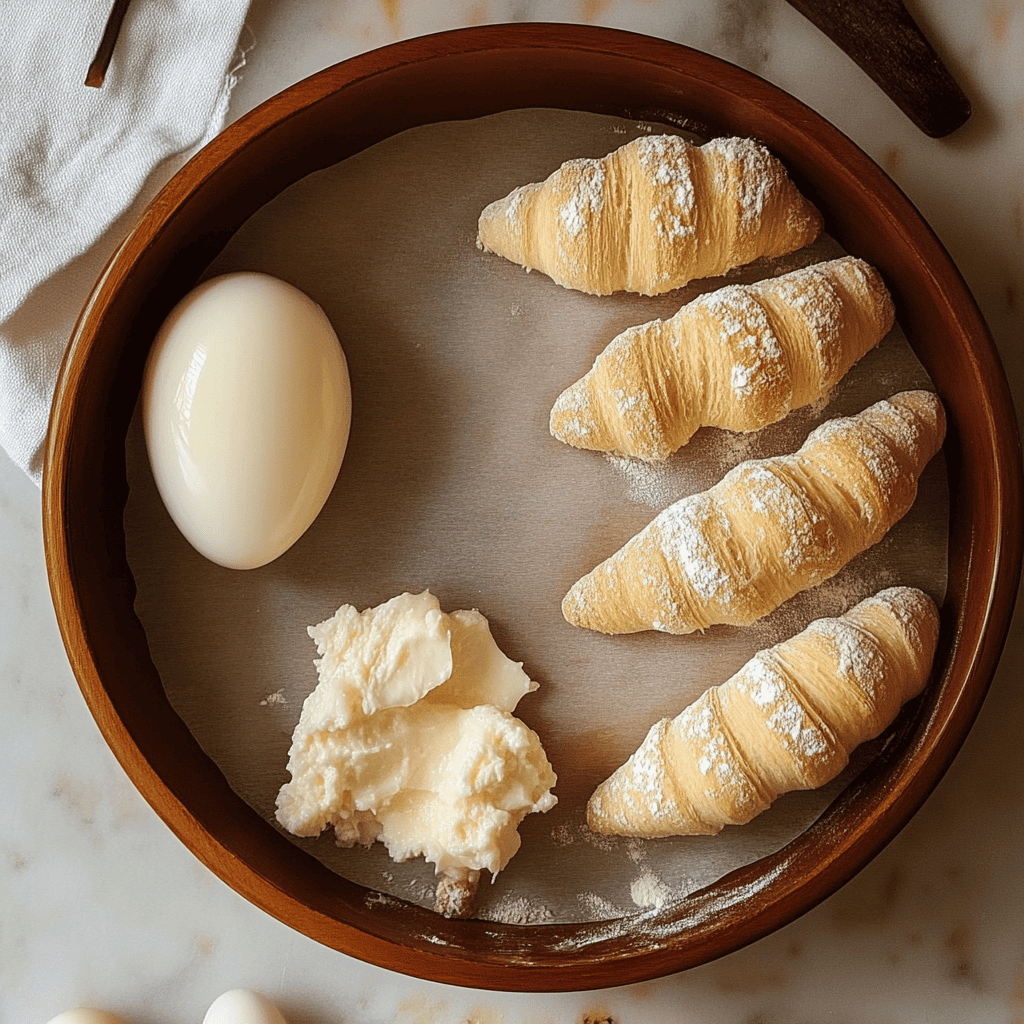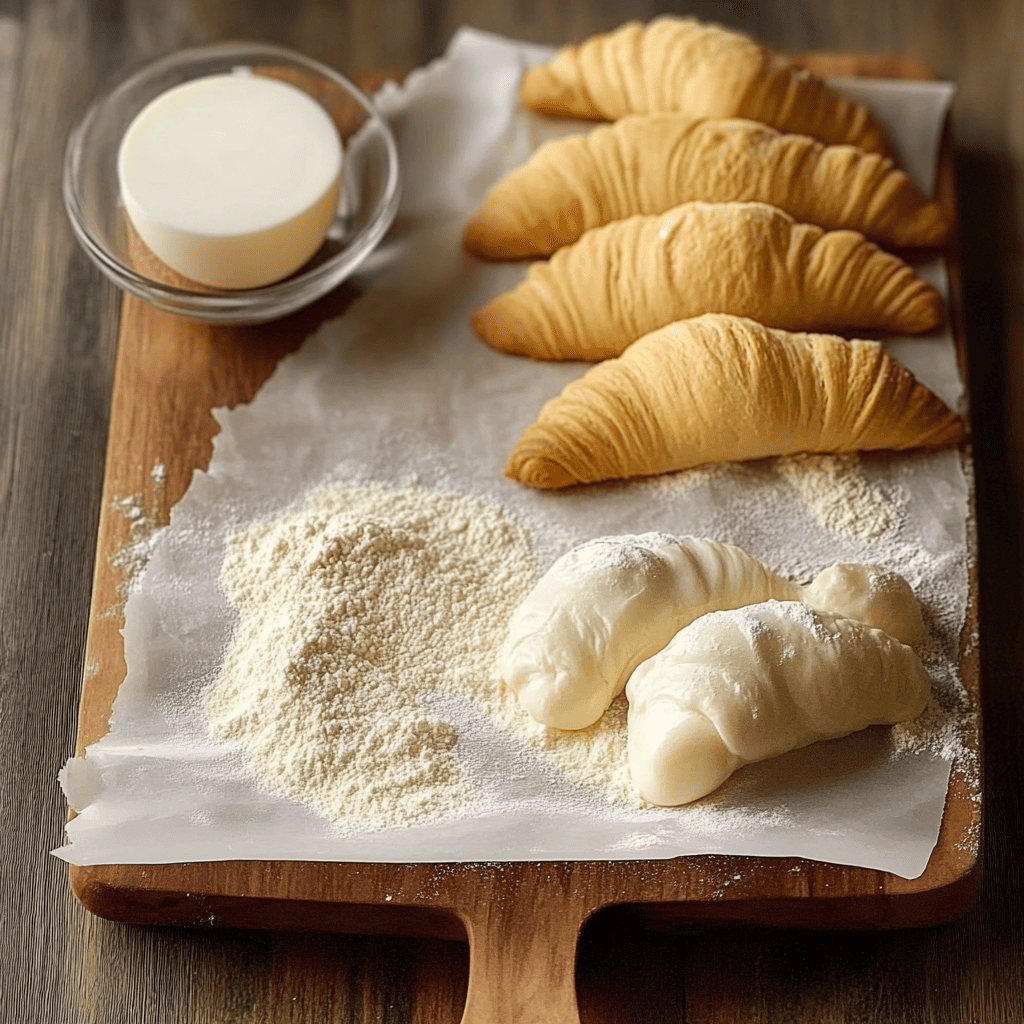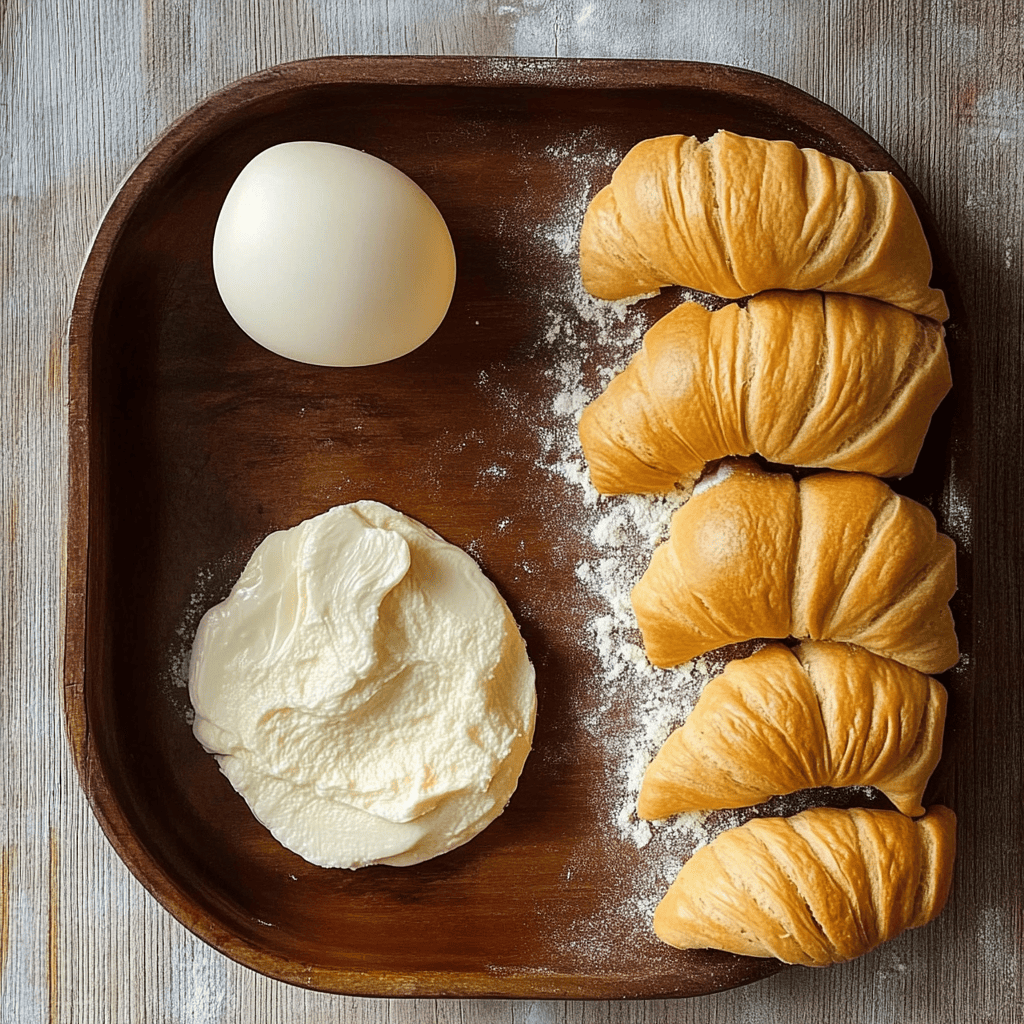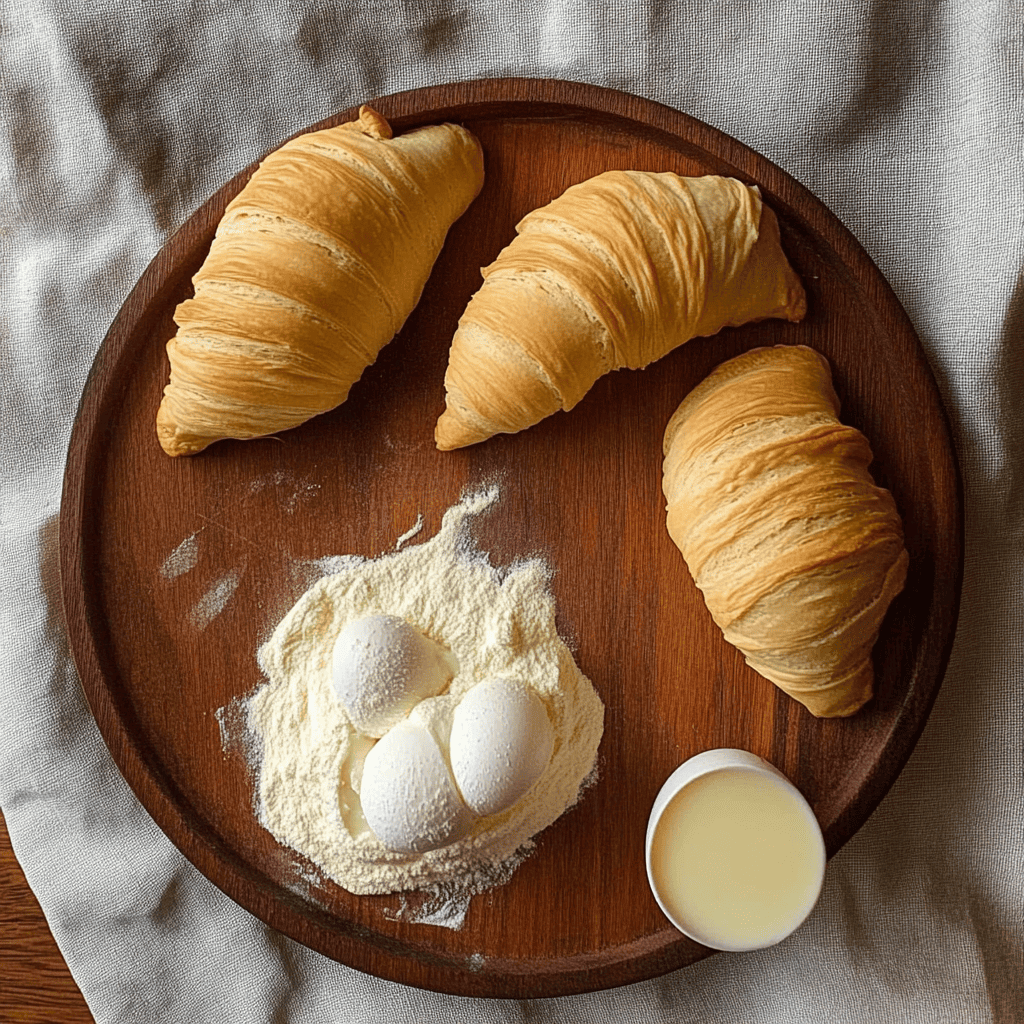Medialunas: The Argentine Classic That Awakens the Senses
Introduction: The Irresistible Aroma of Home Baking
Medialunas are much more than a simple pastry; they’re a bakery icon, especially rooted in Argentine culinary culture, where they’re the undisputed star of breakfast or afternoon snacks. Their crescent shape, golden and slightly caramelized exterior, and tender, spongy interior with that unmistakable buttery flavor make them an irresistible pleasure. Although they’re often compared to French croissants due to their appearance, Argentine medialunas have a personality all their own: they’re sweeter, denser, and have a softer crumb, ideal with coffee with milk or mate. Making them at home means embarking on an aromatic journey that culminates in the satisfaction of savoring a piece of freshly baked bread, a true delight for the palate and the soul.
Detailed History: A Journey from the European “Croissant” to Argentine Identity
The history of croissants is intrinsically linked to that of the European croissant , which originated in Vienna in the 17th century. The most widespread legend tells that the kipferl (a crescent-shaped bun) was created by Viennese bakers to celebrate the victory over the Ottoman Empire during the siege of 1683, adopting the crescent shape of the Ottoman flag. This Viennese bun traveled to France in the 19th century, where it was transformed into the laminated, flaky croissant we know today, thanks to the evolution of French baking techniques.
With the great waves of European migration to Latin America in the late 19th and early 20th centuries, especially from the French, Italians, and Spaniards, these baking traditions arrived on the continent. In Argentina, the croissant was adopted and adapted to local tastes, giving rise to the “medialuna.” Unlike its French cousin, the Argentine medialuna evolved to be less flaky and more brioche-like—that is, more like a sweet bread—with a softer dough, a sweeter flavor, and a more compact and tender crumb. A layer of syrup or glaze is often added upon removal from the oven to give it extra shine and sweetness.
The croissant has established itself as a fundamental element in Argentine gastronomy, being the favorite accompaniment to coffee with milk in bars and cafes, or to mate in homes. It has become a symbol of “breakfast time” or “snack time” and an irreplaceable element in bakeries and confectioneries. Its preparation, although requiring patience due to the rising times, is an act of love and tradition passed down from generation to generation, culminating in the intoxicating aroma that fills the kitchen as they bake. This particular recipe seeks to replicate that magic at home, allowing you to enjoy warm, delicious homemade croissants that evoke the most cherished flavors and memories.
More Details of the Story: Symbolism and Culture in the Medialuna
The medialuna, beyond its flavor, has acquired a strong cultural symbolism in Argentina. Its presence is almost obligatory on the “facturas” (bread rolls and sweet pastries) bought for Sunday family breakfast or when entertaining guests. It represents a moment of pause, enjoyment, and sharing. There are even passionate debates among Argentines about whether they prefer the softer, sweeter, manteca (butter) medialunas or the crunchier, saltier, fat-based ones, demonstrating the deep emotional connection with this pastry.
Kneading technique and rising times are crucial to achieving the perfect croissant texture. The first, long rise allows the yeast to develop the dough’s flavor and elasticity, while the second, shorter rise provides the final lightness before baking. Using butter in the dough, rather than rolling it (as with a croissant ), is what gives it that soft, bouncy crumb. Finally, the glaze or powdered sugar not only adds sweetness and shine, but also serves as the visual signature of this delicious pastry.
This recipe details the step-by-step process, from activating the yeast to baking and final decoration, making the art of preparing homemade croissants accessible to any baking enthusiast. Baking them not only creates a delicious dessert, but also recreates a piece of Argentine culture, filling your home with the unmistakable aroma of a traditional bakery.

Ingredients: The Base of the Abriochada Delight
For the Main Dough:
- 550 g of common wheat flour (strong or baker’s flour is ideal for baked goods)
- 140 g of sugar
- 130 g butter (unsalted, at room temperature)
- 1 egg (large)
- 100 ml of warm water
- 100 ml of warm milk
- 25 g fresh yeast (or 10 g dry baker’s yeast)
- 1 tablespoon vanilla extract or essence
- 5g salt (a generous pinch or a level teaspoon)
To Paint and Decorate:
- 1 egg (beaten, for brushing before baking)
- Icing sugar (for sprinkling at the end)
Detailed Preparation: The Art of Creating Homemade Croissants
Step 1: Activate the Yeast (Previous Ferment)
- In a small bowl, crumble the 25g of fresh yeast (if using dry yeast, dissolve it directly).
- Add 100 ml of warm water, one tablespoon of sugar, and one tablespoon of flour. These amounts of sugar and flour should be subtracted from the total amounts listed under the main ingredients.
- Mix well until the yeast dissolves and all ingredients are combined.
- Cover the bowl with a clean cloth or plastic wrap and let it rest in a warm place for about 20 minutes. You’ll see the mixture become foamy and bubbly, indicating the yeast is active.
Step 2: Knead the Main Dough
- In a large bowl (or the bowl of a stand mixer), place the remaining flour, the remaining sugar, the softened butter cut into pieces, the egg, the warm milk, the tablespoon of vanilla, and the salt.
- Add the activated yeast mixture (the pre-ferment) to the bowl with the rest of the ingredients.
- Hand Kneading: If kneading by hand, turn the mixture out onto a lightly floured work surface. Knead vigorously for at least 10 minutes. At first, the dough may be sticky, but as you knead, it will become more elastic and smooth.
- Kneading in a Stand Mixer: If using a mixer with a hook, knead at medium-low speed for about 10 minutes, until the dough comes away from the sides of the bowl and is elastic and smooth.
Step 3: First Rising of the Dough
- Form a ball with the kneaded dough.
- Lightly grease the same large bowl (where you kneaded) with a little oil to prevent the dough from sticking.
- Place the ball of dough in the bowl, cover it well with plastic wrap or a damp cloth.
- Let the dough rest in a warm place (such as a turned-off oven with the light on, or near a heat source) until it doubles in volume. This process can take between 2 and 4 hours, depending on the room temperature and the activity of the yeast. The recipe indicates it took 3 hours, which is a good average.
Step 4: Degas, Stretch and Cut
- Once the dough has doubled in volume, gently degas it by pressing with your knuckles to release any accumulated air.
- Divide the dough into two equal portions.
- On a lightly floured surface, roll out one of the dough pieces into a rectangle. Try to keep the thickness uniform (approximately 3-4 mm).
- Using a sharp knife or pizza cutter, cut elongated triangles out of the dough. The base of each triangle should be wide enough to fit the base of the crescent (about 7-8 cm), and the height should be sufficient to form several layers when rolled.
- Form the Crescents: From the base of each triangle, roll the dough tightly toward the point. Once rolled, you can fold the points slightly inward to accentuate the crescent shape.
- Place the formed croissants on a baking tray previously lined with baking paper, leaving enough space between them as they will rise again.
Step 5: Second Proofing
- Cover the tray with the croissants with plastic wrap (lightly oiled so it doesn’t stick to the dough) or a clean kitchen towel.
- Let it rise again in a warm place until it doubles in volume. This second rise is quicker, usually between 30 minutes and 1 hour, depending on the room temperature. It should look fluffy and light.
Step 6: Paint and Bake
- While the croissants are in the second rise, preheat your oven to 180º C (356º F).
- Just before baking, beat an egg in a small bowl. Using a pastry brush, gently brush the surface of each croissant with the beaten egg. This will give them a shiny golden color when baked.
- Bake the croissants in the preheated oven for approximately 15 minutes, or until golden brown on top. The middle oven position is ideal.
Step 7: Final Touch and Serve
- Once the croissants are golden brown and cooked, remove them from the oven.
- While they’re still warm, sprinkle generously with powdered sugar. The residual heat will help the sugar adhere.
- Let cool slightly on a wire rack before serving. Enjoy warm or at room temperature.
Estimated Preparation Time
- Active Preparation: 30-40 minutes (kneading, forming, painting)
- First Proofing: 2-4 hours (average 3 hours)
- Second Rising: 30 minutes – 1 hour
- Cooking time: 15 minutes
- Estimated Total Time: 3 hours and 45 minutes to 5 hours and 55 minutes (most of which is rising time).
Additional Tips for Perfect Croissants
- Liquid Temperature: Water and milk should be lukewarm, not hot. Too much heat can kill the yeast.
- Flour Quality: Using strong flour (with high protein content) will help develop gluten and give the croissants a better structure.
- Don’t Add Too Much Flour: When kneading, avoid adding too much flour, as this can make the dough tough. The dough should be soft and elastic.
- Warm Place for Proving: A warm, draft-free environment is crucial for a good rise. Keeping the oven off with the light on is a good trick.
- Space between croissants: Leave enough space between each croissant on the baking sheet so they can rise without sticking together.
- Syrup (Optional): For shinier, sweeter croissants, you can make a simple syrup (same amount of water and sugar, boil until dissolved) and brush them with it right after taking them out of the oven, before adding the powdered sugar.
- Storage: Croissants are best freshly made. They can be stored in an airtight container at room temperature for 1-2 days, or frozen once cooled and warmed gently before serving.

Frequently Asked Questions and Clear Answers
- Can I use dried yeast instead of fresh? Yes, the recipe indicates that 10 g of dried yeast is equivalent to 25 g of fresh yeast. Make sure you use active dry baker’s yeast.
- What should I do if my dough isn’t rising? The most common causes are that the yeast is expired or the water/milk was too hot and killed the yeast. Make sure the liquids are lukewarm.
- Can I make the dough in advance? Yes, you can knead the dough and, instead of a long initial rise at room temperature, do a cold rise in the refrigerator for 8-12 hours (or overnight). This slows fermentation and develops more flavor. Then, continue with the shaping process and the second rise.
- Are these flaky croissants like croissants ? Not exactly. Argentine croissants are more abriochado, meaning more like a sweet bread, and don’t require the rolling and buttering process that defines flaky croissants .
- Can you freeze raw croissants? Yes, you can form them and freeze them on the baking sheet until firm. Then, store them in a zip-top bag. To bake, thaw them at room temperature on the baking sheet, let them rise completely (it may take longer), and then bake as usual.
Texture and Flavor: The Warm Embrace of the Medialuna
- Texture: The homemade croissant is a marvel of textures. Its exterior is lightly golden and crisp, often with a soft sheen if brushed well and dusted with powdered sugar. The interior is incredibly tender, spongy, and with a soft crumb, almost like that of a brioche. It’s not as flaky as a croissant , but denser and more substantial, offering a satisfying bite.
- Flavor: The flavor is predominantly sweet, with a rich buttery note permeating the entire dough. Vanilla adds a warm aromatic touch, and a pinch of salt perfectly balances the sweetness. There’s a subtle yeasty aftertaste, giving it that freshly baked character. When dusted with powdered sugar, the surface sweetness intensifies, creating a comforting and delicious experience.
Consumption Context: When to Enjoy These Delicacies?
Croissants are perfect for:
- Breakfast: The quintessential accompaniment to coffee with milk, mate, or tea in Argentina.
- Snack: An ideal afternoon treat, alone or in company.
- Brunch: Perfect for a brunch table, pairing well with jams, dulce de leche, or simply on their own.
- Family Reunions: A classic to share at meetings or visits.
- Anytime: When you just fancy a sweet, tender, comforting bun.
Visual Aspect: A Sweet Golden Promise
The image of the croissants on the baking tray is a visual delight:
- Phase Contrast: The photo shows both the raw, pale, and perfectly formed croissants (indicating good rising and dough handling) and the already baked ones, with their characteristic deep golden color.
- Classic Shape: The crescent shape is iconic and easily recognizable.
- Tempting Shine: Baked croissants have an appetizing shine, the result of brushing with egg.
- Visible Texture: The layers formed when rolling the dough are visible, even when raw, suggesting a tender crumb.
- Homemade Preparation: The arrangement on the baking tray with baking paper reinforces the idea that they are a fresh, homemade baked product.
Curiosities: Interesting Facts about the Ingredients
- The Role of Yeast: Yeast is a living microorganism that feeds on the sugars in flour and produces carbon dioxide, creating the bubbles that make dough rise and fluff.
- Vanilla in Baking: Although often used as a primary flavoring, vanilla also acts as an enhancer of other sweet and buttery flavors.
- Salt in Sweet Doughs: A small amount of salt is crucial in sweet doughs to enhance the flavor of the other ingredients and balance the sweetness, as well as strengthen the gluten network.
- Softened Butter: It is essential that the butter is at room temperature so that it is evenly incorporated into the dough, creating a smooth and homogeneous texture.
Nutritional Value (Estimated per Unit)
The nutritional value of a croissant can vary significantly depending on the size and the amount of sugar or butter. For a medium-sized croissant, approximate values might be:
- Calories: 180-250 kcal
- Protein: 4-6g
- Total Fat: 8-12g (including saturated fat from butter)
- Carbohydrates: 20-30g (sugars and flour)
- Fiber: 1-2g
- Sugars: 8-15g (added and natural sugars)
- Sodium: 100-150mg
Additional Benefits and Interesting Facts
- The Pleasure of Baking at Home: The process of making croissants is rewarding and fills the house with a delicious aroma.
- Versatility: They can be enjoyed alone, with butter, jam, dulce de leche, or even stuffed with ham and cheese for a savory version.
- Symbol of Comfort: For many, the croissant evokes childhood memories and cozy moments.
- Alternative to baking: Making them at home allows you to control the ingredients and enjoy a fresh product without preservatives.
Other Information
- Allergies: This recipe contains gluten (flour), dairy (milk, butter) and egg.
- Preparation Time: Although the active time is relatively short, the rising time is long, which requires planning.
- Patience is Key: Patience during the rising process is essential for the recipe’s success. Don’t rush the process.

Conclusion: A Bite of Tradition and Homemade Flavor
Medialunas are a true culinary treasure, a treat that combines the simplicity of its ingredients with the complexity of its flavor and texture. This recipe invites you to recreate the magic of Argentine baking in your own kitchen, filling your home with the unmistakable aroma of butter and yeast. Each medialuna is a promise of tenderness and sweetness, perfect for sharing a special moment or simply for a treat. More than a dessert, they are an experience, a tradition celebrated with every bite, uniting people around a table with the warmth of freshly baked bread.

